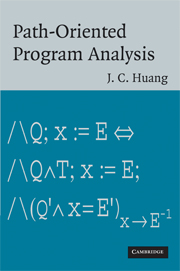Book contents
- Frontmatter
- Contents
- Preface
- 1 Introduction
- 2 State constraints
- 3 Subprogram simplification
- 4 Program set
- 5 Pathwise decomposition
- 6 Tautological constraints
- 7 Program recomposition
- 8 Discussion
- 9 Automatic generation of symbolic traces
- Appendix A Examples
- Appendix B Logico-mathematical background
- References
- Index
1 - Introduction
Published online by Cambridge University Press: 03 September 2009
- Frontmatter
- Contents
- Preface
- 1 Introduction
- 2 State constraints
- 3 Subprogram simplification
- 4 Program set
- 5 Pathwise decomposition
- 6 Tautological constraints
- 7 Program recomposition
- 8 Discussion
- 9 Automatic generation of symbolic traces
- Appendix A Examples
- Appendix B Logico-mathematical background
- References
- Index
Summary
Program analysis is a problem area concerned with methodical extraction of information from programs. It has attracted a great deal of attention from computer scientists since the inception of computer science as an academic discipline. Earlier research efforts were mostly motivated by problems encountered in compiler construction (Aho and Ullman, 1973). Subsequently, the problem area was expanded to include those that arise from development of computer-aided software engineering tools, such as the question of how to detect certain programming errors through static analysis (Fosdick and Osterweil, 1976).
By the mid-1980s, the scope of research in program analysis had greatly expanded to include, among others, investigation of problems in data-flow equations, type inference, and closure analysis. Each of these problem areas was regarded as a separate research domain with its own terminology, problems, and solutions.
Gradually, efforts to extend the methods started to emerge and to produce interesting results. It is now understood that those seemingly disparate problems are related, and we can gain much by studying them in a unified conceptual framework. As the result, there has been a dramatic shift in the research directions in recent years. A great deal of research effort has been directed to investigate the possibilities of extending and combining existent results [see, e.g., Aiken (1999); Amtoft et al. (1999); Cousot and Cousot (1977); Flanagan and Qadeer (2003); and Jones and Nielson (1995)].
In the prevailing terminology, we can say that there are four major approaches to program analysis, viz., data-flow analysis, constraint-based analysis, abstract interpretation, and type-and-effect system (Nielson et al., 2005).
- Type
- Chapter
- Information
- Path-Oriented Program Analysis , pp. 1 - 14Publisher: Cambridge University PressPrint publication year: 2007

